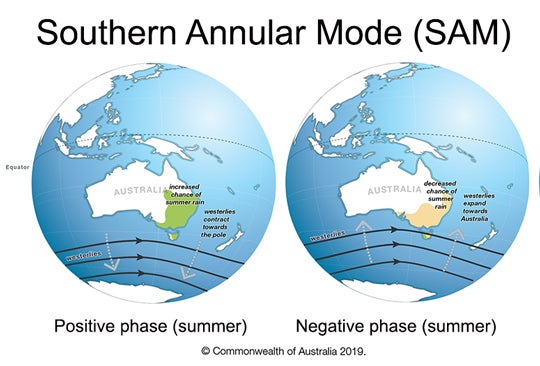2023-06-06 ライス大学

The Southern Annular Mode (SAM) is a climate driver that can influence rainfall and temperature in Australia. The SAM refers to the (non-seasonal) north-south movement of the strong westerly winds that blow almost continuously in the mid- to high-latitudes of the Southern Hemisphere. This belt of westerly winds is also associated with storms and cold fronts that move from west to east, bringing rainfall to southern Australia. (Figure by Australian Bureau of Meteorology)
◆これは大気の内部ダイナミクスから生じるものであり、従来の考え方に反するものでした。この周期性は気候モデリングの分野において大きな影響を持つことが予想されます。また、この発見は将来の気候変動予測のモデルの精度向上に役立つ可能性があります。
<関連情報>
- https://news.rice.edu/news/2023/order-chaos-atmospheres-antarctic-oscillation-has-natural-cycle
- https://agupubs.onlinelibrary.wiley.com/journal/2576604x
南半球の非熱帯大規模大気循環の本質的な150日周期性について The Intrinsic 150‐Day Periodicity of the Southern Hemisphere Extratropical Large‐Scale Atmospheric Circulation
Sandro W. Lubis, Pedram Hassanzadeh
AGU Advances Published: 31 May 2023
DOI:https://doi.org/10.1029/2022AV000833
Abstract
The variability of the Southern Hemisphere (SH) extratropical large-scale circulation is dominated by the Southern Annular Mode (SAM), whose timescale is extensively used as a key metric in evaluating state-of-the-art climate models. Past observational and theoretical studies suggest that the SAM lacks any internally generated (intrinsic) periodicity. Here, we show, using observations and a climate model hierarchy, that the SAM has an intrinsic 150-day periodicity. This periodicity is robustly detectable in the power spectra and principal oscillation patterns (aka dynamical mode decomposition) of the zonal-mean circulation, and in hemispheric-scale precipitation and ocean surface wind stress. The 150-day period is consistent with the predictions of a new reduced-order model for the SAM, which suggests that this periodicity is associated with a complex interaction of turbulent eddies and zonal wind anomalies, as the latter propagate from low to high latitudes. These findings present a rare example of periodic oscillations arising from the internal dynamics of the extratropical turbulent circulations. Based on these findings, we further propose a new metric for evaluating climate models, and show that some of the previously reported shortcomings and improvements in simulating SAM’s variability connect to the models’ ability in reproducing this periodicity. We argue that this periodicity should be considered in evaluating climate models and understanding the past, current, and projected Southern Hemisphere climate variability.
Key Points
- We show using theory, reanalysis data, and a model hierarchy that the Southern Annular Mode has an internally generated 150-day periodicity
- Periodicity is tied to the annular mode’s propagating regime, and affects hemispheric-scale precipitation and ocean surface wind stress
- CMIP models vary in how well they reproduce the periodicity; new metrics are introduced to evaluate these models and understand their biases
Plain Language Summary
The Southern Annular Mode (SAM), which involves hemispheric-scale north-south movement of the midlatitude jet stream, dominates the variability of the Southern Hemisphere (SH) large-scale atmospheric circulation. The SAM has extensive impacts on the Southern Ocean and Antarctica, and the past, current, and future climate of the SH is often viewed through the lens of the SAM. Studies since early 1990s suggested that SAM’s variability lacks any internally generated periodic oscillation, as expected from the turbulent and thus chaotic nature of the midlatitude circulation. However, here we show using observational data, model data, and theory that SAM has an intrinsic 150-day periodicity arising from the internal dynamics of the extratropical atmosphere. This 150-day oscillation clearly influences the variability of the hemispheric-scale precipitation and ocean surface wind stress, suggesting broader impacts of this periodicity on the SH weather and climate. We also found that many state-of-the-art climate models cannot faithfully reproduce this periodicity, providing an explanation for some of the previously reported shortcomings of these models in simulating SAM’s variability. Based on these findings, we propose new metrics and ideas for evaluating these models and understanding their shortcomings, and potentially, improving them.



